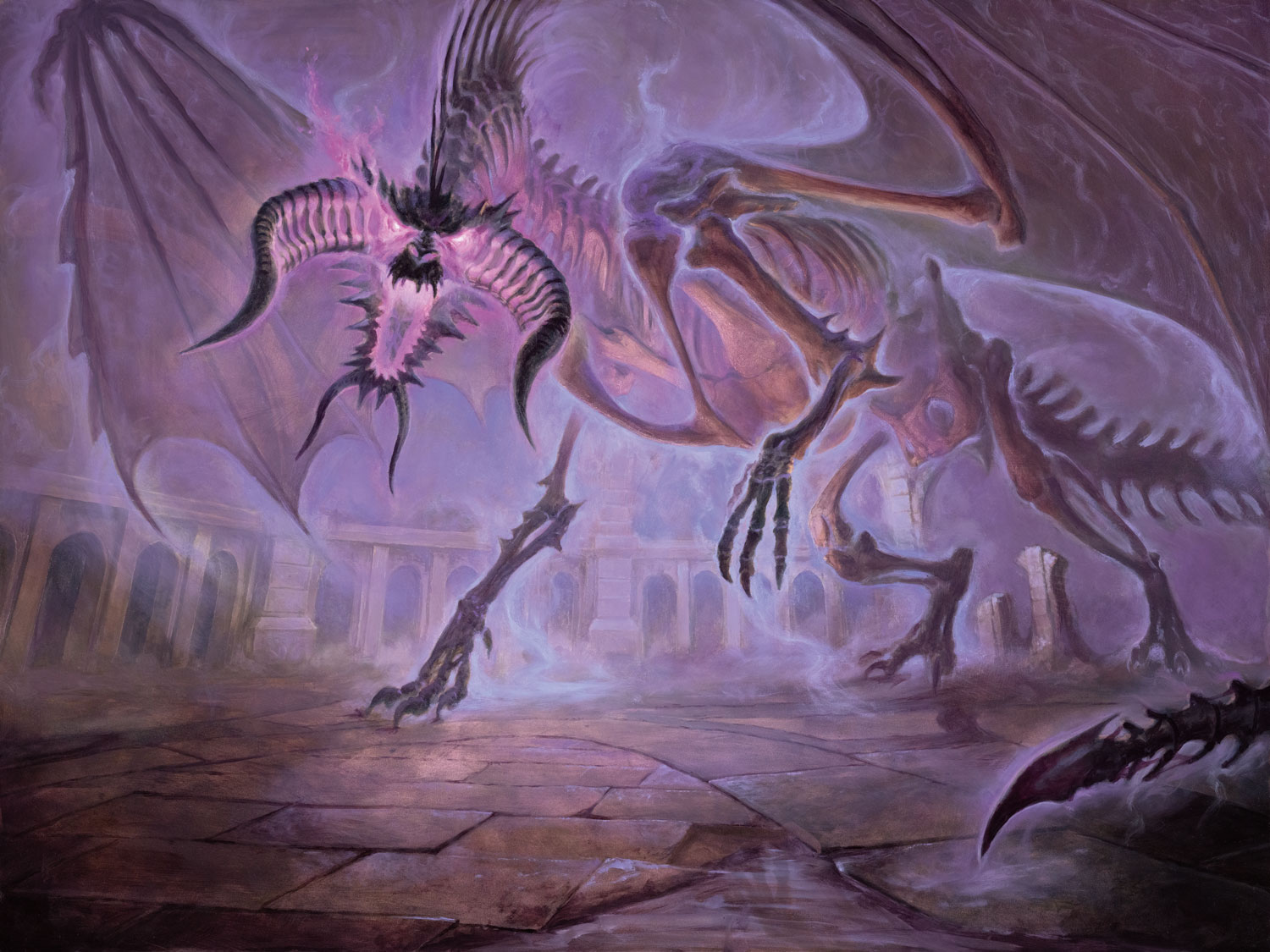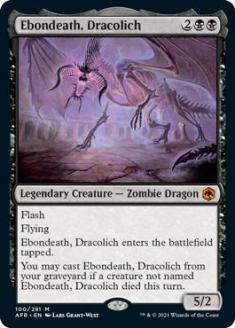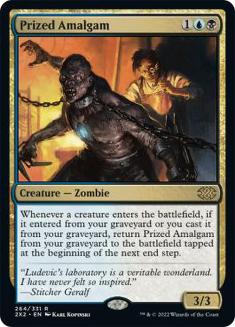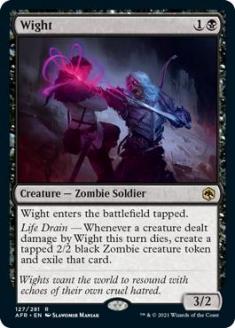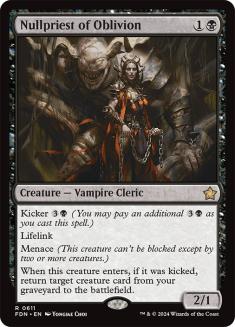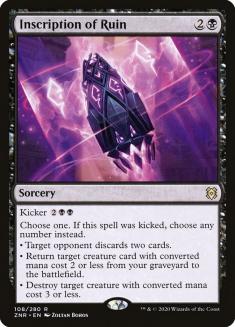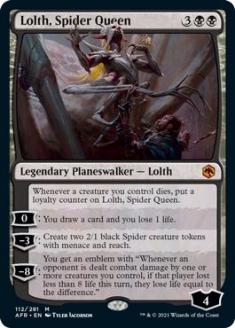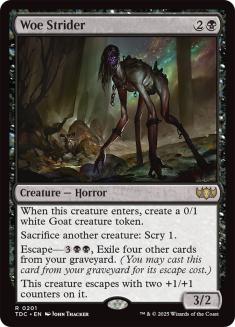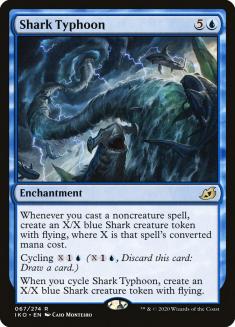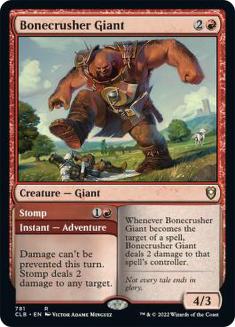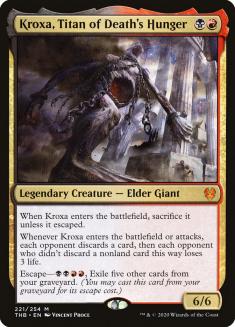Now that the full card list is out for Adventures in the Forgotten Realms, we can dissect all the new cards and try them out in a variety of decks. I’ve seen quite a few spells that have caught my eye, as well as a few creature-lands that will likely see play in a variety of formats. Once Throne of Eldraine rotates from Standard, things will slow down and start to look a bit different. For now, let’s explore the new cards from Adventures in the Forgotten Realms and see what sticks!
Today’s article will focus entirely on Ebondeath, Dracolich, a new legendary Zombie Dragon that never quits. The stat line of five power and flying for four mana is pretty sick. Flash will only matter if you play it in a dedicated control shell, since it enters the battlefield tapped. The last line, however, is where the bread gets buttered.
You may cast Ebondeath, Dracolich from your graveyard if a creature not named Ebondeath, Dracolich died this turn.
Black creatures can often return themselves from the graveyard to the battlefield. You will regularly need to pay a bunch of extra mana for that effect, or suffer some significant drawback on the creature itself. On occasion, you have to jump through a lot of hoops to bring that creature back to the battlefield. Other times still, you’ll find the rare creature that can return to the battlefield without doing much of anything (I’m looking at you, Prized Amalgam).
Ebondeath, Dracolich fits on that same wavelength of cards that have graveyard synergy but the requirement for casting it again can be met in a number of different ways, and those metrics shift based on what archetype you’re playing and what your opponent is playing. My gut tells me that Ebondeath, Dracolich will shine in decks like Mono-Black Devotion. If you’re killing your opponent’s creatures, having a threat that can return for four mana is pretty sick. It has two pips of devotion and provides you with a ton of pressure for a somewhat small investment. Even if your opponent kills it, chances are your removal and disruptive elements will allow the game to continue long enough for you to cast it again.
Creatures (22)
- 4 Gray Merchant of Asphodel
- 4 Murderous Rider
- 3 Ayara, First of Locthwain
- 4 Nullpriest of Oblivion
- 3 Ebondeath, Dracolich
- 4 Wight
Planeswalkers (2)
Lands (20)
Spells (16)
Sideboard

This preliminary build of Mono-Black Devotion looks similar to the old Pack Rat versions from Return to Ravnica Standard. You have so many cards with modal effects, so they’re not really dead against anyone and they can provide you with utility in a number of situations. I tried to put an emphasis on permanents over instants and sorceries. We need to keep the devotion count high enough for Gray Merchant of Asphodel but we also want to be playing the best cards we can at each casting cost.
This is an interesting threat to play in the early turns. If you want to play defense, you can occasionally trade and gain an extra creature out of the deal. If your opponent is low on life, them blocking can lead to a bonus for you. Three power for two mana is also pretty solid.
These dual-natured creatures that are solid against other aggro decks but still have utility against control and midrange are starting to grow on me. Wight, in particular, looks great, though I’m sure it will play out much differently than it looks on paper. After all, you don’t get any sort of bonus when your opponent casts Stomp on it. (Damn you, Bonecrusher Giant!)
I expect games to go pretty long. We have a lot of removal and creatures with “two lives,” which means we’ll be wanting modal threats to go along with them. Nullpriest of Oblivion hasn’t seen much play as of yet, but I feel like this is a perfect spot for it to shine. Not only can you play it early and get some early beats in while giving some lifelink back, but it’s one of the absolute best topdecks you can possibly have. At six mana, gaining two bodies is huge, and especially so when one of those bodies is Gray Merchant of Asphodel.
Continuing our theme of modality, Inscription of Ruin does it all — discard, return, or kill. All three modes are good in various spots, but the turns where you get to pay the kicker cost and get full value will be absurd. The biggest downside of black over the past few years has been a reliance on creature removal as the primary functionality. I love cards that can kill creatures or do something else useful when playing against control. Elspeth’s Nightmare fits this bill as well.
If Gray Merchant of Asphodel isn’t reall your bag, might I suggest something a little different?
Creatures (17)
Planeswalkers (2)
Lands (24)
Spells (17)
- 4 Claim the Firstborn
- 2 The Akroan War
- 4 Heartless Act
- 4 Village Rites
- 2 Bloodchief's Thirst
- 1 Pelakka Predation
Sideboard

Without the companion restriction, we get to open up our payoff spells a little bit. While Jegantha, the Wellspring is certainly fine, I wanted to see just how good Ebondeath could be in a deck with cheap removal and the ability to sacrifice its own creatures for zero or one mana. Once the game starts to go long, having a threat like Ebondeath, Dracolich can be invaluable because it has a high stat line for power, evasion in flying, and can be a surprise threat when your opponent least expects it.
I think Lolth, Spider Queen is pretty sick in a deck like Rakdos Sacrifice. It shouldn’t be hard to get to ultimate if you want, but just having the ability to draw extra cards or create extra bodies is huge. The downside to Lolth is that it has two black pips, which means you can’t play Jegantha, but we were already into that thanks to Ebondeath. Closing the game is occasionally difficult for these decks, but the ultimate on Lolth does it quite efficiently and doesn’t actually seem that difficult to turn on in some matchups.
As we already discussed, having a free sacrifice outlet can be huge. We’ve already seen just what Woe Strider can do alongside Claim the Firstborn, but just being able to cast Ebondeath from the graveyard for four mana after sacrificing a Goat is pretty cool. Woe Strider has been a major part of many sacrifice decks over the past year and change, and I don’t expect that to change anytime soon.
Taking Control
Another place where Ebondeath could shine is in a pure control deck. Since you can cast it from the graveyard after any other creature dies, you can just fill your deck with cheap removal and kill something for one mana before recasting your giant, flying, flashy dragon. Ebondeath can be used defensively, though it does enter the battlefield tapped. It closes the game much more quickly than you might expect, and will likely be paired with Torrential Gearhulk or Shark Typhoon in Historic to give Dimir Control another big flash threat.
Creatures (2)
Planeswalkers (3)
Lands (26)
Spells (29)
- 4 Brainstorm
- 4 Memory Lapse
- 2 Thoughtseize
- 2 Doom Blade
- 3 Fatal Push
- 2 Commit
- 2 Search for Azcanta
- 2 Drown in the Loch
- 2 Cling to Dust
- 4 Shark Typhoon
- 2 Extinction Event
Sideboard

Alongside the flash threat of Ebondeath, Shark Typhoon provides us with some extra pressure with no real drawback. In fact, there will be plenty of games where you make a 1/1 Shark to block, only to flash in Ebondeath from the graveyard. In a pinch, you can just do some racing since the high power of Ebondeath means you can turn the corner quickly. It might not be as swingy as something like Mistbind Clique, but it’s very big for the cost and the evasion makes it really dangerous for your opponent.
The prominence of cheap one-mana removal means we can cast Ebondeath from the graveyard for relatively cheap while still interacting with our opponent. Fabled Passage and Field of Ruin allow us to trigger revolt on Fatal Push to kill larger creatures, which can lead to bigger and bigger blowouts when you get to combo it with Ebondeath.
As far as control decks go, you could make an argument to build this deck like Faeries instead of like a Draw-Go style deck. With enough flash threats, you can dictate the pace of the game. You just need to make sure you have enough cheap interaction to keep up with the more explosive decks in the format. For now, I’ll stick to this, but I wouldn’t be surprised to see Dimir Rogues adopt Ebondeath, but that’s a much tougher sell when you’re losing Lurrus of the Dream-Den.
Companion Lag and Eldraine Looming
One downside to Ebondeath is that it doesn’t work with either Lurrus or Jegantha. Those two companions are often found in the same style of decks where Ebondeath would shine. When these cards rotate out of Standard, I expect a lot of different cards to gain a lot in popularity and playability.
Throne of Eldraine is similarly putting pressure on Standard, boxing out most of the better cards printed in the last few sets by just being too efficient and gaining too much card advantage. The core of Edgewall Innkeeper, Lovestruck Beast, and Bonecrusher Giant is too much for many decks to handle. I can’t tell you how awkward it will be to have my Ebondeath killed by Stomp for the first time. I might concede the match and move on with my life, but that’s just the pressure that these powerful and efficient cards put on the format. They’ve been doing that for almost two years now.
You’re also fighting with Kroxa, Titan of Death’s Hunger in virtually all graveyard-related decks. It’s a tough role to fill because there’s a lot of competition, but I’m confident that Ebondeath is excellent. Once I get to physically play with the card some, I’ll have a better understanding of how to build with it, but my gut is telling me it belongs in a deck that can turn the corner quickly. A flash-style control deck, similar to Dimir Rogues, should be a perfect place for it, but I wouldn’t discount it as a recursive finisher once Kroxa and Lurrus rotate from the format.
Ebondeath, Dracolich is too cheap, hits too hard, and is too easy to recur for it to be dismissed. It might be strong and resilient enough to show up in some Modern decks, but I’ll need some more time to flesh out some lists. The fact that it’s legendary is a little awkward, but just imagine milling over it with Stitcher’s Supplier! What about discarding it to Bone Shards?
The possibilities are endless and I can’t wait to start trying them out.

